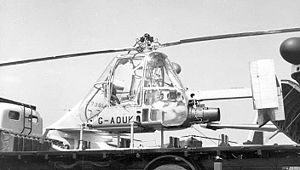Fairey Ultra-light Helicopter Video - Picture

|
|
Fairey Ultra-light Helicopter
Ultra-light Helicopter

Picture - The fourth Ultra-light Helicopter exhibited on a lorry at the 1957 Paris Air Salon
Role: Light Army helicopter
National origin: United Kingdom
Manufacturer: Fairey Aviation Company
First flight: 14 August 1955
Number built: 6
The Fairey Ultra-light Helicopter was a small British military helicopter for reconnaissance and casualty evacuation, designed by the Fairey Aviation Company to be low cost and easily transportable. The project was a casualty of the UK defence economies of the later 1950s.
Development
In 1953, there was a UK government call for a low-cost two-seat helicopter suitable for reconnaissance, casualty evacuation and training duties. The specification was demanding, calling for high speeds and climb rates in tropical conditions. The aircraft also had to be transportable on the back of a standard Army three-ton truck. Fairey's detailed proposal won a contract for four development aircraft and the company decided to build two more as a private venture.
Gas turbines were beginning to appeal to helicopter designers and there was also an interest in producing machines with tip driven rotors, in order to avoid the torque of the conventional shaft drive and the consequent complicated, weighty and vulnerable torque-compensating tail rotor. Some contemporary designs, such as the Sud-Ouest Djinn bled high pressure air from the engine directly to the tips, but Fairey had been developing a drive where this air was mixed with fuel at the tips and burned. Such methods had already been tested on the Fairey Jet Gyrodyne. For the Ultra-light Helicopter, Fairey adopted the French Turbomeca Palouste turbojet, produced under licence by Blackburn, and fitted with an oversized compressor to provide air to the tip-burners at 40 psi (275 kPa).
The Ultra-light Helicopter emerged as a compact side-by-side two-seater with the engine mounted semi-externally at floor level behind the seats. The aircraft was built around a light alloy box with the rotor pylon in the centre and carrying a box girder boom which carried the engine, a horizontal tailplane and vertical stabilizer and rudder surfaces. The rudder projected below the boom into the jet efflux and provided yaw control even when the aircraft was stationary. The undercarriage was a simple pair of skids attached to the box structure. The pylon carried a tip driven two blade rotor, mounted as a see-saw combination without drag or individual flapping hinges.
The aircraft first flew in August 1955 and appeared at the September Society of British Aircraft Constructors (SBAC) show at Farnborough that year. Though the first four military machines were built, defence economies left the Ultra-light without Ministry support by mid-1956 and Fairey had to develop it at their own expense. Several modifications were made to the first prototype. This machine originally had only the rudder at the end of the boom, but a horizontal tailplane bearing end-plate fins was added. A less obvious change was the addition of hydraulically assisted cyclic pitch control. The second prototype had a modified cabin which allowed stretcher-born casualties to be carried. Two Ultra-lights had slightly larger diameter rotors (32 ft/9.75 m rather than 28 ft/8.6 m) to improve performance in situations where compactness was not at a premium. There were many demonstrations of the Ultra-light's capabilities at airshows, in nuclear war exercises and aboard ship (HMS Grenville). Civil airworthiness certification was achieved in 1958. Despite interest from abroad, particularly the USA and Canada, no orders were received and only the six aircraft were built before the programme was abandoned in 1959.
Specifications
Data from Taylor 1974, p. 404
General characteristics
Crew: 2
Length: 15 ft 0 in (4.57 m)
Height: 8 ft 2 in (2.49 m)
Empty weight: 959 lb (435 kg)
Gross weight: 1,800 lb (817 kg)
Performance
Cruise speed: 95 mph (153 km/h)
Range: (under tropical conditions) 180 miles (290 km)
Endurance: max, tropical 2.5 hours
Service ceiling: hovering, out of ground effect 4,800 ft (1,463 m)
Rate of climb: sea level 950 ft/min (4.83 m/s)
Comparable aircraft
Sud-Ouest Djinn
Bibliography
Taylor, H.O. (1974). Fairey Aircraft since 1915. London: Putnam Publishing. ISBN 0 370 00065 X.
Fairey Ultra-light Helicopter Pictures
More aircraft.
Source: WikiPedia